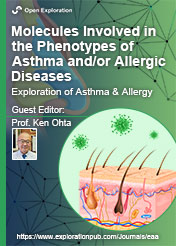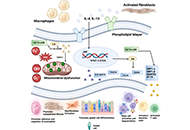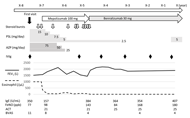-
 Special Issue Topic
Special Issue TopicMolecules Involved in the Phenotypes of Asthma and/or Allergic Diseases
Submission Deadline: September 30, 2024Guest Editor
Ken Ohta E-Mail
President, Japan Anti-Tuberculosis Association (JATA) Fukujuji Hospital; Honorary President, NHO Tokyo National Hospital, Tokyo, Japan
Research Keywords: Hard-to-treat asthma, animal model, guidelines for asthma and COPD, molecular mechanisms of asthma and allergy, biologics for asthma therapy
About the Special Issue
It has been recognized that asthma is a kind of syndrome rather than a disease since it has various faces, so called phenotypes which we need to recognize for precision medicine. Phenotypes have been believed to be derived from various molecules, which are named as endotypes after being confirmed their involvement in and relationship with phenotypes. The molecules thus identified could be a new biomarker, a new therapeutic target or a hint for clarifying molecular mechanisms of asthma and/or allergic diseases.
When I look back our research, the first step to develop a therapeutic strategy was development of a murine asthma model in 1990s when only a few groups including ourselves were able to establish the model for their own research. In our case, we observed elevated levels of granulocyte-macrophage colony-stimulating factor (GM-CSF) in BALF from asthma patients, so we raised a question if GM-CSF is functionally involved in the pathogenesis of asthma. I thought up use of a neutralizing antibody to GM-CSF in our murine asthma model. The next hurdle was how to administer the antibody to a mouse. We have chosen two ways, i.e. the systemic administration by using an osmotic capsule and the local airway instillation by intranasal dripping. As we expected, the antibody neutralized the targeting cytokine, i.e. GM-CSF, functionally in the both ways of administration. We were able to contribute to developing a new way of studying the cytokine biology in the field of asthma by using neutralizing antibodies and a murine asthma model, and to showing a new therapeutic strategy with neutralizing antibodies as biologics.
In this special issue, we would like publish manuscripts giving us new scientific information with a good quality of data and discussion contributable to discovering new roles of molecules.
Keywords: Asthma, allergic diseases, molecules, phenotypes
Call for Papers
Published Articles
 Deciphering the role of 12/15-lipoxygenase in asthma: insights into mitochondrial dysfunction and therapeutic implicationsOpen AccessReviewThis review delves into the complex role of 12/15-lipoxygenase (12/15-LOX) in asthma pathogenesis, focusing on its contributions to mitochondrial dysfunction, oxidative stress, epithelial injury, an [...] Read more.Mandya V. Greeshma ... Padukudru Anand MaheshPublished: October 22, 2024 Explor Asthma Allergy. 2024;2:529–550
Deciphering the role of 12/15-lipoxygenase in asthma: insights into mitochondrial dysfunction and therapeutic implicationsOpen AccessReviewThis review delves into the complex role of 12/15-lipoxygenase (12/15-LOX) in asthma pathogenesis, focusing on its contributions to mitochondrial dysfunction, oxidative stress, epithelial injury, an [...] Read more.Mandya V. Greeshma ... Padukudru Anand MaheshPublished: October 22, 2024 Explor Asthma Allergy. 2024;2:529–550
DOI: https://doi.org/10.37349/eaa.2024.00063 Long-term efficacy of mepolizumab on eosinophilic granulomatosis with polyangiitis: a retrospective studyOpen AccessOriginal ArticleAim: Eosinophilic granulomatosis with polyangiitis (EGPA) is a vasculitis characterized by eosinophilic inflammation. Patients with EGPA are treated with systemic glucocorticoids and immunosuppre [...] Read more.Takahiro Matsuyama ... Hiromasa InouePublished: September 19, 2024 Explor Asthma Allergy. 2024;2:461–472
Long-term efficacy of mepolizumab on eosinophilic granulomatosis with polyangiitis: a retrospective studyOpen AccessOriginal ArticleAim: Eosinophilic granulomatosis with polyangiitis (EGPA) is a vasculitis characterized by eosinophilic inflammation. Patients with EGPA are treated with systemic glucocorticoids and immunosuppre [...] Read more.Takahiro Matsuyama ... Hiromasa InouePublished: September 19, 2024 Explor Asthma Allergy. 2024;2:461–472
DOI: https://doi.org/10.37349/eaa.2024.00058 -
-
Ongoing Special Issues
-
Completed Special Issues